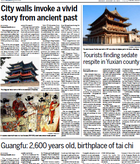-
Tourists finding sedate respite in Yuxian county
After intensive days touring the grandeur of Beijing's imperial palaces and gardens, increasing numbers of tourists take a relaxing trip to a county 250 kilometer west of the national capital to experience another kind of cultural charm.
The history of Yuxian paper-cutting stretches back more than 200 years. The traditional art form is mostly used in window decorations, so a finished work is also called a window flower.City walls invoke a vivid story from ancient past
Most cities and towns along the Great Wall have their origins as important military bases to defend against nomadic tribes from the north, and the ancient city of Xuanhua in Hebei province is no exception.
One of the nine strongest fortresses along the Great Wall, its garrison had more than 100,000 soldiers during the Ming Dynasty (1358-1644), compared with a civilian population of only several thousand. -
Guangfu: 2,600 years old, birthplace of tai chi
The ancient town of Guangfu, in Yongnian county, Hebei province might be as unknown to the outside world as millions of other settlements in China except for a singular fact - it is the birthplace of tai chi.
Historic Hebei rich in antiquityWhile Xanadu in Inner Mongolia, the summer capital of the Yuan Dynasty (1271-1368), was made a World Heritage site in June, conservation efforts are also underway for the remains of another of the dynasty's capitals.
Imperial opulence lives on at Qing tomb complexThe Egyptian pyramids and tombs of its ancient pharaohs are renowned over the world, but few outside China are familiar with the Eastern Royal Tombs of the Qing Dynasty (1644-1911), the largest, most complete and best-preserved extant mausoleum complex in China.
 News
News
Guangfu: 2,600 years old, birthplace of tai chi
The ancient town of Guangfu, in Yongnian county, Hebei province might be known to the outside world in China as the birthplace of tai chi.




